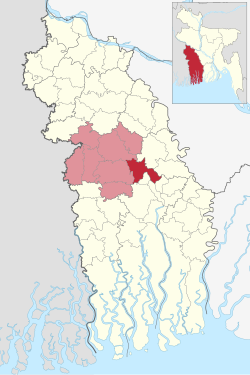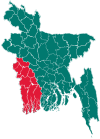Abhaynagar Upazila
 From Wikipedia the free encyclopedia
From Wikipedia the free encyclopedia
Abhaynagar অভয়নগর | |
|---|---|
 Mukteshwari River, Abhaynagar | |
 | |
| Coordinates: 23°1′N 89°26′E / 23.017°N 89.433°E | |
| Country | |
| Division | Khulna |
| District | Jessore |
| Area | |
| • Total | 247.21 km2 (95.45 sq mi) |
| Population (2011)[1] | |
| • Total | 262,434 |
| • Density | 1,100/km2 (2,700/sq mi) |
| Time zone | UTC+6 (BST) |
| Website | Official Map of Abhaynagar |
Abhaynagar (Bengali: অভয়নগর) is an upazila of Jessore District in the Division of Khulna, Bangladesh.
History[edit]
During the Bangladesh Liberation war, staff of the Noapara Railway Station were killed by members of Pakistan Army on 27 March 1971. The Pakistan Army killed 17 members of Mukti Bahini including Assistant Secretary of Bangladesh Awami League Nazibor Rahman.[2]
On 4 December 2005 over 300,000 people of Abhaynagar took to the roads and blocked the Jessore-Khulna Highway in the Nowapaara industrial area to protest against a longstanding waterlogging problem. The protest followed a silt removal drive by 25,000 people in the Sri River at Vobodoho sluice gate on November 9. Over 100 people were injured in violent clashes during the protest.[3]
Demographics[edit]
As of the 2011 Bangladesh census, Abhaynagar upazila had 62,189 households and a population of 262,434. 51,171 (19.50%) were under 10 years of age. Abhaynagar had an average literacy rate of 59.80%, compared to the national average of 51.8%, and a sex ratio of 990 females per 1,000 males. 85,856 (32.72%) of the population lived in urban areas.[1] Ethnic population was 4,232 (1.61%).[4]
In the 1991 Bangladesh census, Abhaynagar's population was 204,654, with males constituting 52.06% of the population and females 47.94%. The population aged 18 or above was 110,761, with a literacy rate of 38.8% (7+ years) compared to a national average of 32.4%.[5]
Economy[edit]
The principal agricultural products are rice, wheat, jute, potatoes, garlic, onions, mustard, betel nuts, brinjal and vegetables. The principal industrial products are jute, textiles, leather, salt and cement:[citation needed]
Points of interest[edit]
Among the archeological interests in Abhaynagar are Siddhipasha Rajbari with its adjacent tank and temple, 11 Duari Mandir, Madhayapur Neelkuthi and Sreedharpur Zamindar Bari. Three periodicals are published: the weekly Mukti and Uddipan, and the monthly Mukul.
Administration[edit]
Abhaynagar Upazila is divided into Abhaynagar Municipality and eight union parishads: Baghutia, Chalishia, Payra, Prambag, Siddhipasha, Sreedharpur, Subha Para, and Sundoli. The union parishads are subdivided into 89 mauzas and 106 villages.[1]
See also[edit]
References[edit]
- ^ a b c d "Bangladesh Population and Housing Census 2011 Zila Report – Jessore" (PDF). bbs.gov.bd. Bangladesh Bureau of Statistics.
- ^ "Abhaynagar Upazila". Banglapedia. Retrieved 2019-01-01.
- ^ "Hundreds of people block Jessore-Khulna Highway". New Age. 2005-12-04. Archived from the original on 2007-09-30. Retrieved 2006-02-18.
- ^ "Community Tables: Jhenaidah district" (PDF). bbs.gov.bd. Bangladesh Bureau of Statistics. 2011.
- ^ "Population Census Wing, BBS". Archived from the original on March 27, 2005. Retrieved November 10, 2006.
External links[edit]
- Md. Saifur Rahman (2012). "Abhaynagar Upazila". In Sirajul Islam (ed.). Banglapedia: National Encyclopedia of Bangladesh. Asiatic Society of Bangladesh.
